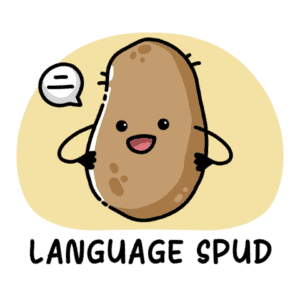There are literally thousands of Mandarin Chinese learning resources on the market, and they weren’t created equally.
On my quest to learn Mandarin Chinese, I’ve been through my fair share of them.
After wasting countless hours trying to find the holy grail of instant fluency, I must admit that I’ve failed in that regard.
Apologies, I have no magic ‘instant fluency potion’ to recommend.
However, what I do have is hindsight. And if you’re a total beginner to Mandarin Chinese who is feeling lost and doesn’t know how to move forward with your studies, hopefully, this post will help you a great deal.
If I had my time again, this is what I’d do to get started.
GETTING STARTED
If you’re a super fresh newbie to Mandarin Chinese, you’re likely incredibly enthusiastic and have lofty plans to become fluent in a year.
Now I don’t enjoy being a doubting Thomas, but this isn’t going to happen.
I’m sorry. Again.
I was like this as well. When I told advanced speakers of my goals, they would smile and nod and say, “Good luck, bro.” I felt patronised, but they were right.
If you’re like I was, you’re probably willing to sink a lot of money into your new project, too. You’re also probably willing to spend an inordinate amount of time looking for shortcuts, study hacks, and perfect resources to get you fluent as quickly as possible.
All the while, you’re oblivious to the fact you should be actually spending time with the language.
This is how you do that as a newbie…
FREE APPS
Because almost every learner is like the one mentioned above, I always recommend making use of free apps first. Other benefits to starting out with free apps include:
- They’re free, obviously – If you try them out and then two weeks later decide learning Mandarin isn’t for you, you don’t lose a dime.
- They’re easy to use – You can study when riding the train or having a poo.
- They’re ‘routine fodder’ – A good routine is essential for language learners, and it’s easy to develop a routine using apps because they’re super convenient. Starting a routine and sticking to it is your first real test for going the distance in learning Mandarin.
- They’re effective – You’ll never become fluent from apps alone, but they’re surprisngly effective and can take you quite far.
The following three apps do a great job of delivering a Chinese language learning program covering all of the absolute basics, and they’re all fairly similar. Each lesson is around 10 minutes long and will introduce a new set of vocabulary and a useful grammar point.
Chinese Skill

The best of the three as it provides the most learning content. Offers a premium course that offers a lot of really good learning content.
RATING: 8/10
Hello Chinese

This app is neater and tidier than Duolingo with better audio and structure. A shorter course than Chinese Skill
RATING: 7/10
Duolingo

Not the best language course on Duolingo. It does the job though and you could do a lot worse with a free app.
RATING: 7/10
Will you reach a high level of Mandarin from using these apps? Absolutely not.
However, they’re a sift, light, gentle, free intro to Mandarin Chinese.
For a more detailed review of Duolingo’s Mandarin course, check this out.
SRS (Spaced Repition Software) FLASHCARD APPS
If you’re using an app to solely focus on learning characters, you’ll want one with spaced repetition software.
Luckily, most apps on the market now have this feature.
In another post, I’ve talked about how learning new words and characters via flashcard apps can lose its effectiveness over time. However, as a newbie, using flashcard apps can help you learn those all-important few hundred words and characters much more quickly.
Anki

Probably the most popular flashcard app, Anki gives you more customisation options than any other app on the market. Free for Android users, $24.99 on the iOS app store.
RATING: 9/10
Pleco

One of the paid add-ons with Pleco is the Flaschard option. It’s really good and has customisation options, but not as many as Anki. Importing wordlists is easy.
RATING: 9/10
Memrise

A gamier app than Anki, but there are loads of pre-made word lists on the database to use, just like Anki. The free version is enough, although the app is sometimes buggy.
RATING: 8/10
Pleco
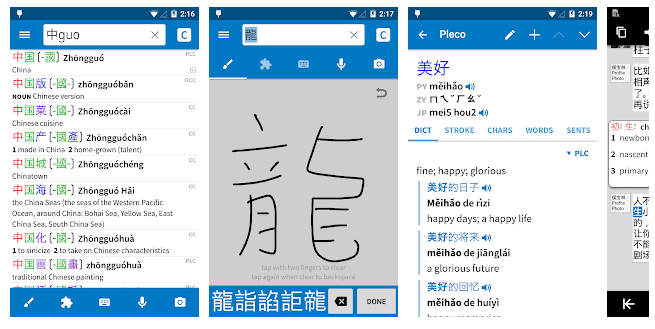
You’ll see me ranting and raving about Pleco all over this site, and for good reason.
In my opinion, Pleco is an absolute must-have for every learner of Mandarin Chinese.
Not only is it the best comprehensive dictionary app on the market, but it’s much more than that. Pleco has loads of incredibly useful functions and add-ons, including an OCR text translator, a handwriting app, a document reader, native speaker audio, and a flashcard function.
You can download and use the Pleco dictionary for free, but some of the optional paid add-ons are totally worth it. The
- Basic Bundle ($29.99) includes all of the features mentioned above, and this is what I and most of my foreign colleagues use in China.
- Professional Bundle (US $59.99) provides some other fancy bells and whistles, but the basic bundle is probably all you’ll ever need.
Check out the video below for a more comprehensive Pleco review.
Handwriting
Handwriting is kind of controversial topic amongst a lot of foreign Mandarin learners.
On the one hand, there are many learners out there who shun handwriting as a waste of time when it comes to learning Mandarin. On the other, there are learners who may feel you’re not a true admirer of the language if you ignore the skill of writing by hand.
I always recommend newbies to at least practice writing a few hundred characters to get a feel for the language and learn the vital radicals and components.
| HANDWRITING PROS | HANDWRITING CONS |
| – If you know how to write a character by hand, you won’t forget it. – You’ll have a deeper understanding of the structure of the language, specifically with radicals and character components. – You’ll fare much better at Chinese universities where writing is commonplace. – You will become much better at denoting meaning from new words and characters you don’t know yet. – It looks cool. | – It takes absolutely forever to learn how to write. – Seriously, it’s the most time-intensive aspect of learning the language. – In the modern world it brings little practical reward. Characters are written mostly on the computer and on a phone. – You’ll waste a lot of paper. – If your goal is to acquire the language and communicate, writing will waste valuable time that could be spent reading, listening, and speaking. |
Writing Textbooks
Some people are against using apps for writing, and I totally understand that. A quill, a monocle, and some ink were good enough for our ancestors, so it should be good enough for us as well.
The action of writing on paper is also much more fluid and comfortable than fiddling about with a small phone screen, too. The drawback is you don’t get the spaced repetition software, and if you have a terrible memory (like myself) this can prove problematic.
These are all good textbooks for writing practice, so they aren’t placed in any particular order of quality.
Basic Mandarin Chinese
This book is a solid choice for beginners – a workbook for the 288 highest-frequency characters and 700 words in Chinese. Designed to have you reading and writing simple, connected Chinese sentences quickly.
Reading and Writing Chinese
If you’re looking for a comprehensive writing textbook, this one should fit the bill. This book could potentially lead you throughout your entire character writing journey as it covers all HSK levels from total beginner to advanced.
Learning Mandarin Chinese Characters
If you’re intimidated by the gigantic atlas of Chinese that is my previous suggestion, this one might be more up your street. It will cover all of the bases of HSK 1 and give you plenty of space to practice.
If you want a simple, cheap, blank notepad to practice writing characters, you can find them here.
If you’re well and truly addicted to technology and must to everything on your phone, the following two apps are by far the best handwriting apps for Chinese.
Skritter
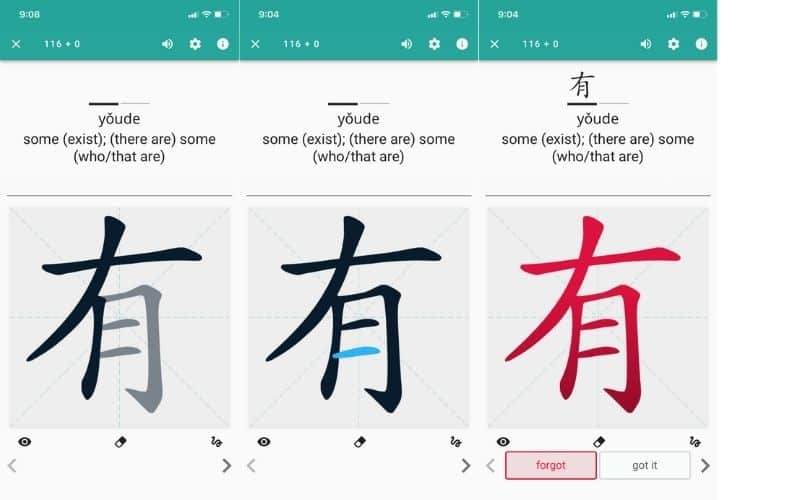
No other handwriting app comes close to Skritter. You can import wordlists, choose one from the extensive database, or manually create your own.
It uses spaced repetition and also provides stroke order diagrams and tweaks to the character presentation.
$14.99 a month isn’t cheap, but long-term subscriptions can bring this price down to $8.33 per month. If you need to learn how to write, it’s worth the price tag.
Pleco
“Jeez, how many more times is this guy going to mention Pleco?” Probably a few more.
Pleco’s handwriting app is second to Skritter, but not too far behind. To test yourself on writing in the flashcard section, simply look to the top of the card and press the ‘字’.
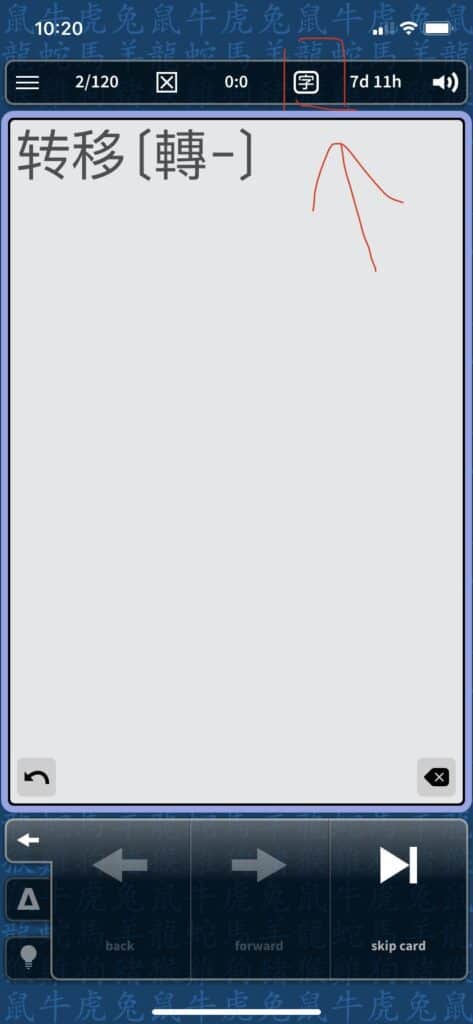
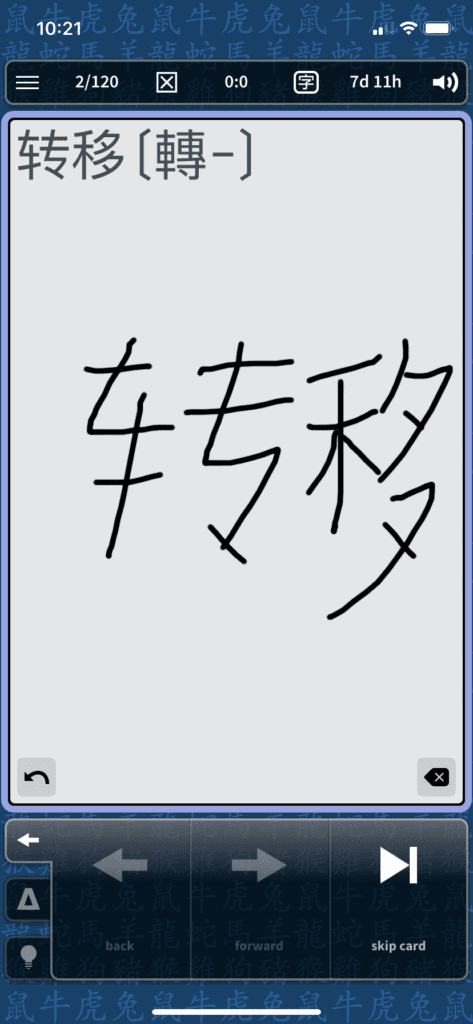
Comprehensive Textbooks
Some people see textbooks as boring, and many of them are. Even the most interesting ones will never set your world on fire. However, I still believe they are an incredibly useful tool to guide you and add structure to your learning. As an advanced learner, I still use them today.
Each chapter contains a word list and a written conversation introducing the new vocabulary and grammar structure. You can listen to the audio of each section via the accompanied CDs (or copy it to iTunes), and the chapters link into each other very well.
Boya Series
The BOYA series is my personal favourite textbook. Geared more towards functional Chinese, it was the course textbook used during my studies at Sun-Yat Sen University in Guangzhou, 2017.
RATING: 9/10
Developing Chinese
Developing Chinese textbooks are used in other university language courses in China. There tends to be more content in these books, but I still prefer Boya for the layout and structure.
RATING: 8/10
The HSK Series
The HSK textbooks aren’t the best, but considering most students of Chinese want to align their studies with HSK (Chinese Proficiency Test) it’s useful to align your studies with the exam.
RATING: 8/10
Sentence Mining
Sentence mining is the learning of sentences through the spaced repetition system, and it’s incredibly effective for a number of reasons. With sentence mining you are…
- Learning new words in context
- Learning grammar and sentence structure
- Learning how to formulate your own sentences as you recognise language patterns through repetition
Just like learning characters through SRS apps, there’s a chance sentence mining might become tedious over time.
However, it’s yet another efficient way to learn Mandarin Chinese for newbies.
Glossika
Probably the most well-known sentence mining tool on the market, and if used regularly over a long time you can go very far with it. However, there are a few issues with it: it’s expensive, it phonetically translates loads of weird names (unnecessary), and it’s riddled with language errors.
RATING: 7/10
Speechling
Does everything that Glossika does for free. It’s an app, too. Sure, the interface is a bit messier and the app is sometimes buggy, but it’s free. You can also get your own private tutor through the paid version of the app.
RATING: 9/10
Clozemaster
Clozemaster is an app in which you learn new words in the context of sentences. Is that sentence mining? I’m not quite so sure, but what I’m definitely sure of is the Clozemaster methods works. The interface makes the app look kind of ancient and the free version is almost useless, but $60 a year for premium is good value and I’ve made the purchase myself.
RATING: 9/10
Reading
Extensive reading and listening are activities that will take you to your highest heights in Mandarin, but as a beginner, you don’t have enough language to be able to do this yet. Your core textbook can help you with this, but you want to be reading as much as possible early on.
Two awesome graded reading apps for beginners are…
The Chairman’s Bao
The Chairman’s Bao app (TCB) has a huge collection of short news articles divided into various HSK levels (including 1 and 2). The articles are about a range of different topics subjects which are written in Mandarin by native Chinese professors. All you’ve got to do is choose the stories which match your interests and reading level.
RATING: 9/10
Du Chinese
Equally as awesome as The Chairman’s Bao. It’s difficult to separate these apps as they’re both incredibly similar. Du Chinese has slightly fewer pieces of content on their database but they do have a more diverse range of articles. For example, there are loads of short stories and mini-story lessons as well as news articles.
RATING: 9/10
In fact, these apps are so good, I even made a video about them!
Graded Readers
Graded readers are incredibly useful for those who want to begin reading but are at a late beginner/early intermediate stage. You can find my recommendations for graded readers here.
Speaking
There is quite a debate among polyglots and advanced learners about how important speaking is as a newbie. Some advocate speaking as much as possible right from the get-go, and others prefer to focus on the acquisition of language as a beginner and start speaking later.
I’m with the second group.
Basically, you want to have acquired enough of the language before you attempt to have a conversation, otherwise, you’re just wasting everyone’s time.
And how do we acquire language? Through our eyes and our ears.
Still, there’s a lot to be said about the benefits of having a tutor.
- Learning Structure – if you’re really struggling how to learn and prioritise your time, a private tutor can help.
- Speaking – Yeah, OK, I know I just said you didn’t need this yet, but every little helps.
- Explanations – Good teachers can help clarify difficult language points.
- Human Interaction – Sometimes it’s just nice to speak to someone…
If you aren’t in Mainland China, finding opportunities to have conversations in Chinese can be tough. You can choose to hire a local tutor which will probably be quite expensive, or you can get on Tinder and try to match with a Chinese student close to you (there’ll probably be quite a few).
For a cheaper alternative, you can use online tutors and language exchange partners.
HelloTalk

With HelloTalk, you can find language exchange students online that are interested in learning your native tongue. You can chat with your language partner in a number of ways, but the live video chat service is only available as part of the premium plan. However, there’s nothing stopping you from exchanging skype details with a language partner and taking it from there. Be wary of people who use Hello Talk as a dating app.
RATING: 7/10
iTalki

iTalki is the most popular site and app for language learners to find private teachers online. Video introductions and reviews of Chinese teachers and native speakers will help you decide on which one is best for you. iTalki is awesome and I have used it regularly, but just be warned that it can take some time to find a teacher you click with. Make use of trial classes. Lessons usually cost between $10-$30 an hour depending on the experience and reputation of your teacher.
RATING: 9/10
Pimsleur
Pimsleur is unique in that its courses are entirely audio which you listen to and then repeat verbally. The way the course is structured may seem a little repetitive, but it really works. Each 30-minute lesson builds on the last and gradually and gets you speaking more and more.
I think Pimsleur is perfect for complete beginners who want to reach a lower intermediate level of speaking as quickly as possible.
The main downside to Pimsleur is the whopping price tag of 500 dollars for all courses. They do have a more reasonable option of a $14.95 a month subscription, but I still feel like it’s pricey for a resource with no visual content.
RATING: 8/10
For a full video review of Pimsleur and recommendations for a cheaper alternative, check out the video below.
Listening
Listening and reading go hand in hand in your quest to acquire Mandarin Chinese, but here’s what a lot of people won’t tell you.
Listening in Mandarin Chinese is objectively difficult.
The short sounds, the tones, the accents, and dialects that change words completely – there’s a reason that almost all TV shows and movies in China come with subtitles!
The only way to overcome this is through practice.
Lots and lots of practice.
Once again, your textbooks are a good source of listening material suited to your level, as well as…
Chinesepod
This is my main tool for studying Chinese through listening, and it has been for a long time. ChinesePod provides thousands of 10-minute podcasts (longer for advanced learners) covering a huge range of interesting and useful topics. You’ll listen to some Chinese dialogue, and the two speakers on the podcast will break down the exchange so after a few listens, you’ll have a much fuller understanding of the exchange.
RATING: 9/10
Chinese Class 101

ChineseClass101 is another site and app that is solely focussed on podcasts. The advanced lessons aren’t up to much in my opinion, but that doesn’t matter because the beginner stuff is great, and that’s what you need. All podcasts follow a similar structure (albeit slightly more formal) to Chinesepod.
RATING: 8/10
Listening Resource Collection
Over the years, I have compiled a fairly large collection of Chinese media that makes for excellent listening content.
Some of the TV shows and movies aren’t suited to beginners but still make for excellent exposure if watched with English subtitles.
However, there are a number of excellent YouTube channels which provide a lot of good listening content for beginners.
Check out the posts below to learn more.
- Learning Chinese: 15+ Listening Tools Perfect for Beginners
- 57 of the Best YouTube Channels for Learning Mandarin Chinese
- 100+ Podcasts for Learning Chinese | Beginner to Advanced Material
- 101 TV Shows for Chinese Learners | Drama, Action, Comedy, and More!
- Learn Mandarin with Film | 101 Awesome Chinese and Taiwanese Movies
Comprehensive Online Courses
Few comprehensive courses on the internet successfully attempt to cover all aspects of Mandarin learning successfully. For most learners, it’s best to mix and match tools and resources to suit your individual needs and preferences.
However, there is one online course that I think really stands out from the crowd…
Yoyo Chinese
Yoyo Chinese has a lot of plus points and considerable thought and effort has clearly been put into each area of the course. Some of the things I particularly enjoy are:
- Short, engaging video lessons. I can’t concentrate for long periods of time and I start to zone out if my study session is more than 10 minutes long. The video lessons are downloadable for you to watch and listen to wherever you are.
- A structured curriculum. This is something missing from my most other resources on this list, except for the textbooks. Sure, you have access to specific wordlists on the flashcard apps, and you get progress categories on my beloved Chinesepod, but a structured curriculum is seriously beneficial to beginners.
- Yoyo Chinese hits learning from every angle. Videos, audio, quizzes, flashcards – you name it. Yoyo Chinese courses really go above and beyond to keep you stimulated and motivated to learn. They have so many helpful videos available on YouTube for free as well. Check out the following introductory lesson on Chinese tones!
RATING: 9/10
Summary
The above mentioned are the tip of the iceberg when it comes to Mandarin learning resources.
Although these are my strong recommendations for newbies, once you progress and feel the need for new content, make sure to check out the links below!
